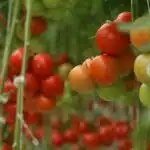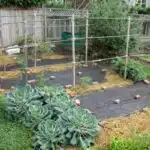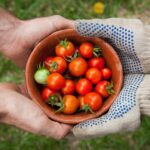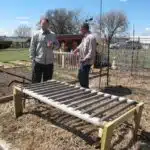Tomatoes are a staple in many households, adding flavor and nutrition to meals year-round. Growing your own tomatoes can be a rewarding experience, providing you with fresh, flavorful fruit straight from your garden. However, not everyone has the knowledge or experience necessary to successfully grow healthy tomato plants. In this article, we will cover everything you need to know about growing tomatoes, from selecting the right variety for your climate to caring for your plants throughout the growing season.
As a tomato growing expert, I have seen firsthand how satisfying it can be to produce your own crops. Whether you are an experienced gardener or a beginner looking to try their hand at growing tomatoes for the first time, there are several factors that can affect the success of your harvest. By following the tips and guidelines provided in this article, you can ensure that your tomato plants thrive and produce an abundance of delicious fruit for you and your family to enjoy. So let’s dive into everything you need to know about growing tomatoes!
Choosing The Right Tomato Variety
To grow healthy and flavorful tomatoes, it is essential to choose the right variety. The best season for growing tomatoes depends on your location and the climate in your area. Tomatoes thrive in warm weather, so it’s ideal to plant them after the last frost has passed. In most regions, this would mean planting in late spring or early summer.
When selecting a tomato variety, consider your flavor preferences. Some people prefer sweet and juicy tomatoes, while others enjoy a more acidic taste. The color of the fruit also varies from red to yellow and even green when ripe. Additionally, there are determinate and indeterminate varieties that differ in size and growth habit. Determinate types produce fruit all at once and are better suited for container gardening, while indeterminate varieties continue growing throughout the season.
Understanding soil and sunlight needs are crucial factors in selecting the right tomato variety for you. Tomatoes require well-draining soil that is rich in organic matter such as compost or aged manure. They also need at least six hours of direct sunlight daily to thrive. When you have chosen your preferred variety of tomato plant, ensure that you select a location with adequate sunlight exposure and prepare the soil accordingly to give your plants a healthy start.
Understanding Soil And Sunlight Needs
Now that you have chosen the right tomato variety, it is important to understand their soil and sunlight needs. Tomatoes thrive in well-draining soil that is rich in organic matter. Before planting your tomatoes, it is essential to test your soil to determine its pH level and nutrient content. You can purchase a soil testing kit at your local garden center or send a sample to a lab for analysis.
Sunlight plays a crucial role in the growth and development of tomato plants. They require at least 6-8 hours of direct sunlight daily to produce healthy fruit. However, excessive heat can cause sunscald on the fruit and stress out the plant. Shade management is crucial for maintaining optimal growing conditions for your tomatoes. You can use shade cloth or strategically place taller plants around them to provide some relief from the scorching sun.
Before planting your tomatoes, prepare your garden bed by clearing any debris and weeds. Add compost or aged manure to improve the soil’s fertility and structure. Next, create raised beds or mounds to promote drainage and ensure good air circulation around the plants’ roots. Finally, water your newly planted tomatoes thoroughly and mulch around them with straw or leaves to conserve moisture and suppress weed growth.
As you move forward with growing tomatoes, remember that proper soil testing and shade management are key factors in producing healthy plants with bountiful yields. By preparing your garden bed correctly, you set yourself up for success in producing delicious homegrown tomatoes that will surely impress both family and friends alike!
Preparing Your Garden Bed
- Proper soil preparation is essential for successful tomato growth. The soil should be amended to ensure a balance of nutrients, pH, and drainage.
- Tomato seedlings should be planted at a depth of two to three inches below the surface to ensure strong root development.
- As tomatoes are a space-intensive crop, spacing requirements should be carefully considered. Generally, indeterminate varieties should be planted 24-36 inches apart and determinate varieties should be spaced 18-24 inches apart.
- The soil should be worked to a depth of 12-15 inches. This ensures that the roots can access the nutrients available in the soil.
- When planting, it is important to place the seedling at the same depth as it was in the container it was purchased in.
- To ensure a healthy plant, the soil should be kept moist but not saturated. Mulch should be applied to help retain moisture and prevent weeds.
Soil Preparation
As a tomato growing expert, I know that soil preparation is a crucial step in the process of growing healthy and juicy tomatoes. The first thing you need to do is to test your soil for pH level and nutrient content. Soil testing can be easily done using a simple kit that can be purchased at any garden center. This will help you identify the areas that need improvement and make sure that your plants have everything they need to thrive.
Once you have identified the areas that require attention, it’s time to start preparing your garden bed by adding organic matter. Composting benefits are numerous as it helps improve soil fertility, structure, and water-holding capacity. Adding compost to your soil also helps balance its pH level and encourages beneficial microorganisms to thrive. A good rule of thumb is to add about 2-3 inches of compost per year on top of your existing soil.
Finally, before planting your tomato seedlings, it’s important to mix the compost into the soil thoroughly. This will ensure that the nutrients are distributed evenly and will provide even growth for all plants. Remember, successful tomato growing starts with proper preparation of the soil – so take the time to get it right! By following these steps, you’ll be well on your way to harvesting bountiful crops of delicious tomatoes in no time.
Planting Depth
Now that we have discussed soil preparation, let’s move on to the next important step in tomato growing: planting depth. One common mistake that many gardeners make is planting their tomato seedlings too deep or too shallow. This can lead to stunted growth, poor fruit production, and even plant death. To avoid this, it’s important to understand the optimal planting depth for your tomato plants.
The ideal planting depth for tomato seedlings is about two-thirds of the stem buried underground. This means that you should remove the lower leaves from the stem and plant the seedling with only the top third of leaves above ground level. Planting at this depth will allow your tomato plants to develop a strong root system while also providing support for the stem.
In addition to proper planting depth, it’s important to ensure optimal conditions for your tomato plants. This includes providing them with plenty of sunlight (at least 6-8 hours per day), regular watering (about 1-2 inches per week), and proper spacing (about 18-24 inches apart). By following these guidelines, you can help your tomato plants grow healthy and strong, leading to a bountiful harvest of delicious tomatoes.
Spacing Requirements
Proper spacing is another important factor to consider when preparing your garden bed for tomato growing. Adequate space between plants allows for good air circulation, which can help prevent diseases and pests from spreading. It also ensures that each plant has enough room to grow and develop properly.
When it comes to spacing requirements, the general rule of thumb is to plant tomato seedlings about 18-24 inches apart. However, this may vary depending on the variety of tomato you are growing. Some varieties require more space than others due to their size or growth habits. Be sure to check the specific recommendations for the variety you plan to grow.
Companion planting and intercropping techniques can also be used to maximize space in your garden bed while still allowing your tomatoes to thrive. For example, planting basil or marigolds alongside your tomato plants can help repel pests and attract beneficial insects, while also providing a delicious herb for cooking. Intercropping with other vegetables such as peppers or cucumbers can also help make the most of limited space while promoting healthy soil and plant growth.
Planting Your Tomato Seedlings
Did you know that the timing of transplanting your tomato seedlings can have a significant impact on their growth and yield? According to a study by the University of California, Davis, transplanting too early can result in stunted growth, while transplanting too late can cause delayed production. In general, it is recommended to wait until after the last frost date in your area before transplanting.
Once you have determined the optimal transplant timing for your tomato seedlings, it is important to prepare them for life outside of their indoor environment. This process is known as hardening off and involves gradually exposing your plants to outdoor conditions over a period of 7-10 days. To do this successfully, start by placing your seedlings outdoors in a sheltered spot for 2-3 hours per day and gradually increase the time and exposure to sunlight each day.
To ensure successful transplantation and healthy growth of your tomato plants, there are three key things to keep in mind:
- Choose an appropriate location with full sun exposure and well-draining soil.
- Dig a hole that is deep enough to accommodate the entire root ball without bending or breaking any roots.
- Water your transplanted seedlings immediately after planting and regularly thereafter.
Now that you have successfully transplanted your tomato seedlings using proper hardening off techniques, it’s time to focus on their ongoing care. The next step in growing healthy and productive tomato plants involves learning how to properly water and fertilize them.
Watering And Fertilizing Your Plants
Watering and fertilizing are essential components of growing healthy tomato plants. Consistent watering is necessary to ensure adequate moisture levels in the soil, while fertilizer provides the necessary nutrients for optimal growth. To water your plants effectively, consider using drip irrigation systems that deliver water directly to the base of the plant. This method reduces water waste and ensures that the roots receive adequate moisture.
When it comes to fertilizing your tomato plants, there are several organic options available. One popular choice is compost, which can be added to the soil before planting or as a top dressing during the growing season. Another option is organic liquid fertilizers, which can be applied directly to the soil or foliage. These fertilizers contain nutrients such as nitrogen, phosphorus, and potassium that are essential for plant growth.
It’s important to note that over-fertilization can harm your tomato plants by causing excessive foliage growth at the expense of fruit production. To avoid this problem, follow recommended application rates and frequency for your chosen fertilizer type. With proper watering and fertilization techniques, you’ll be on your way to harvesting a bumper crop of delicious tomatoes in no time.
Moving on from watering and fertilizing our tomato plants, let’s discuss another crucial aspect of their care: pruning and supporting.
Pruning And Supporting Your Tomato Plants
Pruning is an essential task for tomato plant care and involves the removal of certain parts of the plant. Supporting and staking tomato plants is necessary to prevent them from toppling over and breaking due to their heavy fruit. Training and tying up tomato plants helps to keep the branches and vines off the ground and can increase yields. Pruning techniques, frequency, support structures, trellising, tools, and pruning for yield, disease prevention, size control, sunlight exposure, and air circulation should all be considered when caring for tomato plants.
Pruning
To ensure that your tomato plants grow healthy and strong, pruning is an essential technique that every gardener should learn. There are two types of pruning techniques that you can use to keep your tomato plants in good shape: determinate and indeterminate. Determinate tomatoes only require minimal pruning, while indeterminate tomatoes need regular pruning throughout the growing season.
The best time to prune tomatoes is early in the morning when the temperature is cool and the sun isn’t too intense. This will help minimize stress on the plants and reduce the risk of damage or disease. When pruning, it’s important to use clean, sharp tools to make clean cuts that heal quickly.
When it comes to pruning, there are several key areas of focus. First, remove any suckers that appear between the main stem and branches. These suckers can steal nutrients from the plant and reduce overall fruit production. Second, remove any leaves that are yellowing or damaged as they can also sap energy from the plant. Lastly, trim back any branches or shoots that are growing too close together or touching the ground as they can create a breeding ground for pests and disease. By following these simple steps, you’ll be able to prune your tomato plants like a pro!
Supporting
After discussing the importance of pruning tomato plants, it is now time to delve into the topic of supporting them. Supporting your tomato plants is equally important as pruning as it helps prevent breakage and improves overall plant health. Using the best materials and proper techniques for support can help give your tomatoes a better chance at producing a bountiful harvest.
One of the best materials you can use for supporting your tomato plants is a sturdy stake or cage. Stakes are best used for determinate varieties, while cages are ideal for indeterminate varieties. Properly securing the stem to the stake or cage can help prevent wind damage, broken branches, and fruit rot due to contact with soil. When using stakes, make sure they are at least 6 feet tall and driven at least 1 foot deep into the ground. For cages, choose ones that have a diameter of at least 18 inches and are made from durable material such as galvanized steel.
Proper technique is also important when supporting your tomato plants. It’s recommended to install stakes or cages at the time of planting to minimize damage to growing roots later in the season. As your tomato plant grows taller, gently tie it to the support structure with soft twine or fabric strips, being careful not to constrict its growth or cause damage to stems or leaves. By providing proper support during their growth stages, you’ll be able to enjoy healthy and fruitful tomato plants throughout the season!
Identifying And Treating Common Tomato Plant Problems
As a tomato grower, it is important to be aware of the pests and diseases that can harm your plants. Identifying these issues early on can help you take action to prevent them from spreading and causing irreversible damage to your crop.
Identifying Pests:
- Aphids: small insects that feed on sap and cause yellowing leaves
- Whiteflies: tiny insects that suck plant juices, spread viruses, and leave behind sticky honeydew
- Cutworms: larvae that cut through stems at ground level, killing young plants
- Spider mites: tiny arachnids that spin webs and cause yellow or brown spots on leaves
Preventing Diseases:
- Blight: fungal disease causing brown spots & death of leaves, stems, & fruit
- Blossom-end rot: calcium deficiency causing black/brown patches on the bottom of fruit
- Septoria leaf spot: fungal disease causing small brown spots on leaves which spread over time
- Early blight: fungal disease causing dark concentric rings on older leaves followed by yellowing
By monitoring your plants regularly for signs of pests or diseases, you can take preventative measures such as pruning affected areas or applying organic insecticides to protect your crop. Remember to always follow the instructions carefully when using any type of pesticide or fungicide.
Moving forward, it’s important to start thinking about harvesting and storing your tomatoes. To ensure optimal flavor and longevity, there are several key steps you should follow in order to preserve the quality of your crop.
Harvesting And Storing Your Tomatoes
Identifying and treating common tomato plant problems can be a challenging task, but once you have overcome them, it’s time to reap the rewards of your hard work. Harvesting and storing your tomatoes is the next step in the process of enjoying fresh and delicious tomatoes all year round. The key to harvesting perfectly ripe tomatoes is to wait until they have reached their full ripeness.
Tomato ripeness is determined by the stage of development that the tomato has reached. When a tomato plant begins to produce fruit, it will take some time for the fruit to reach its maximum size and flavor potential. As the tomato ripens, it changes color from green to red, yellow or orange depending on the variety. The best way to determine if a tomato is ripe is by gently squeezing it; if it gives slightly under pressure, then it’s ready for harvest.
Once you have harvested your tomatoes at their peak ripeness, there are several preservation techniques you can use to ensure that they last longer. One popular technique is canning, which involves sterilizing jars and filling them with cooked tomatoes before sealing them with a lid. Another method is freezing, where you blanch your tomatoes in boiling water for one minute before peeling and freezing them in an airtight container.
| Preservation Technique | Pros | Cons | Cost |
|---|---|---|---|
| Canning | Long shelf life | Requires special equipment | Moderate |
| Freezing | Easy process | Can cause freezer burn over time | Low |
| Drying | Intense flavor concentration | Time-consuming process | High |
Saving seeds for future seasons is an important aspect of growing tomatoes that many gardeners overlook. By saving seeds from your own plants rather than buying new ones each season, you can save money and preserve heirloom varieties for generations to come. To save tomato seeds, simply scoop out the pulp from a ripe tomato into a jar with water and let it sit for a few days until the mixture ferments. Once the seeds have sunk to the bottom of the jar, pour off the pulp and rinse the seeds before drying them on a paper towel. Store your dried seeds in an airtight container in a cool, dry place until you’re ready to plant them next season.
Saving Seeds For Future Seasons
Saving tomato seeds is a great way to preserve the variety of tomatoes you have grown and ensure that you have a steady supply of seeds for future planting seasons. To save tomato seeds, begin by selecting the best and healthiest fruits from your harvest. These fruits should be fully ripe and free from any signs of disease or damage.
Once you have selected your tomatoes, cut them open and remove the seeds along with their gelatinous coating. Place these in a container filled with water and allow them to ferment for two to three days. During this time, the fermentation process will break down the gel around the seeds, making it easier to separate them from one another.
After fermentation, rinse the seeds thoroughly and dry them completely before storing them in an airtight container. Proper seed storage is key to preserving their viability over time. Keep your saved tomato seeds in a cool, dark place with low humidity levels such as a refrigerator or freezer until you are ready to plant them again.
As important as saving seed is ensuring that those saved seeds germinate successfully when planted. Before planting saved seed, consider using germination techniques such as soaking or scarification to increase success rates. Soaking involves placing your saved seed in water overnight before planting while scarification entails gently nicking or scratching the seed coat before planting. Both techniques can help improve the chances of successful germination and ultimately a bountiful harvest of delicious tomatoes.
Moving on to tips for success and troubleshooting…
Tips For Success And Troubleshooting
Now that you have saved your tomato seeds for next season, it’s time to focus on maximizing your yield. One of the most common mistakes made by tomato growers is not providing enough water. Tomatoes need consistent watering throughout the growing season, as uneven watering can lead to blossom end rot and splitting.
Another mistake commonly made by growers is not pruning their plants properly. Pruning helps to increase airflow and sunlight exposure, which can lead to larger and healthier fruit. It’s important to remove any suckers or branches that are growing too closely together, as well as any leaves that are blocking sunlight from reaching the fruit.
To further maximize your yield, it’s important to fertilize your plants regularly with a balanced fertilizer. This will provide them with the necessary nutrients they need to grow strong and healthy. Additionally, be sure to keep an eye out for any pests or diseases that may affect your plants, and address them promptly before they cause significant damage.
By following these tips for success and troubleshooting common mistakes in tomato growing, you can expect a bountiful harvest of delicious tomatoes. Remember to provide consistent watering, proper pruning, regular fertilization, and attentive pest management in order to achieve optimal results. Happy gardening!
Conclusion
In conclusion, growing tomatoes can be a rewarding and enjoyable experience when done correctly. By choosing the right tomato variety, understanding soil and sunlight needs, preparing your garden bed, planting your seedlings properly, watering and fertilizing your plants regularly, identifying and treating common tomato plant problems, harvesting and storing your tomatoes properly, saving seeds for future seasons and following tips for success and troubleshooting; you can successfully grow juicy red tomatoes that are perfect for salads, sauces or even eating fresh off the vine.
While some may argue that growing tomatoes is time-consuming and requires too much effort, it is important to remember that the end result is worth it. Imagine biting into a freshly picked ripe tomato that you grew yourself. The sweet taste of summer bursting in your mouth with every bite. This delicious experience cannot compare to the bland store-bought tomatoes that lack flavor. Growing your own tomatoes allows you to have control over the quality of the produce you consume while enjoying the therapeutic benefits of gardening. Don’t let fears hold you back from experiencing this delightful journey of growing your own tomatoes!
Image Credits
- “Growing Tomatoes” by OakleyOriginals (featured)





























